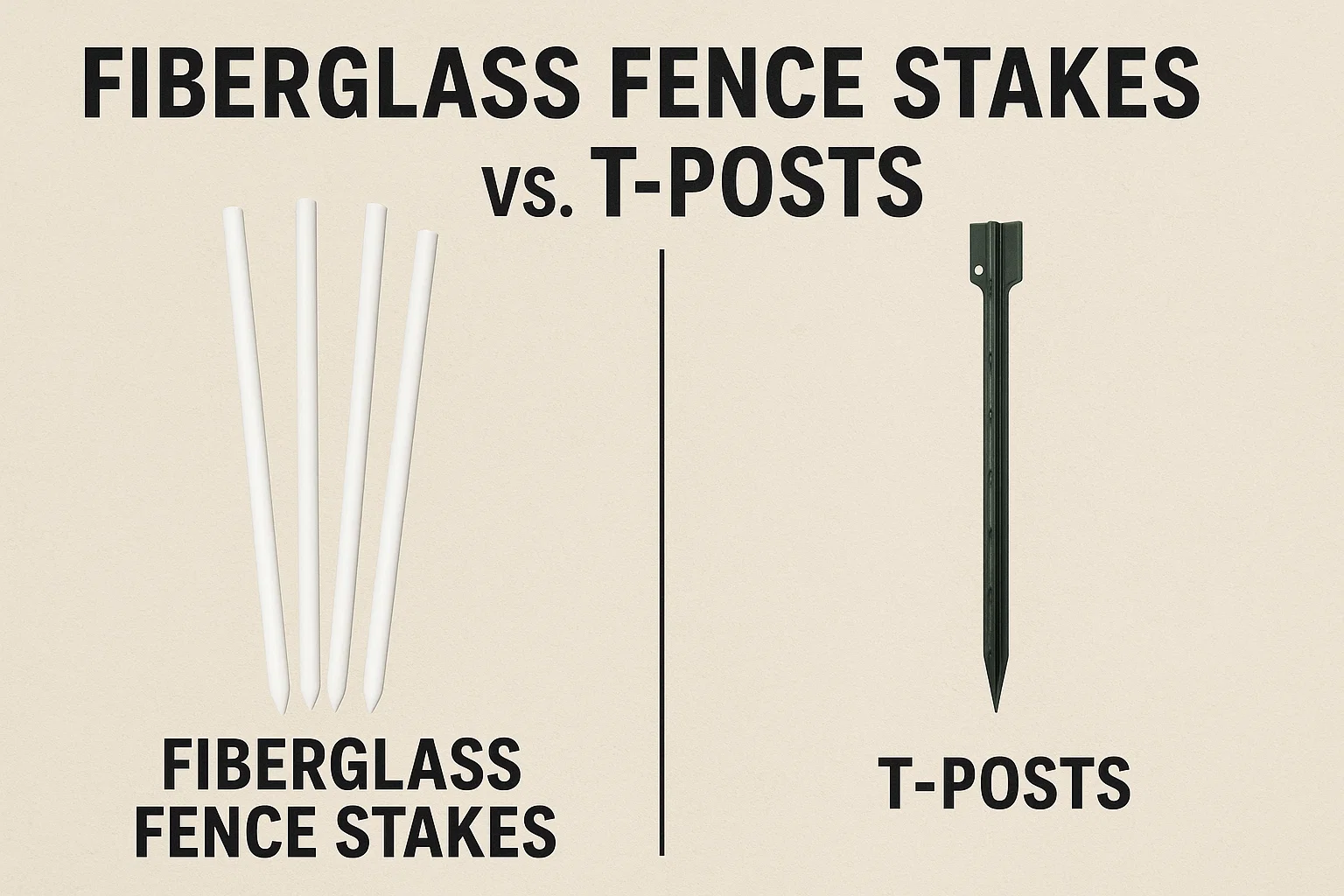Introduction
Choosing the right fence support is a mission‑critical decision for project managers who maintain long transmission corridors, vegetable farms, or construction perimeters. The materials you specify shape safety records, long‑term budgets, and even worker morale. Unicomposite, an ISO‑certified pultrusion manufacturer with decades of field experience, produces fiberglass‑reinforced plastic (FRP) stakes that challenge conventional steel T‑posts on every metric that matters.

fiberglass fence stakes
Understand the Basics: Materials & Manufacturing
What Are Fiberglass Fence Stakes?
Fiberglass stakes are pultruded profiles made of continuous glass fibers locked in a thermoset resin matrix. The result is a flexible, non‑conductive rod that resists weather, chemicals, and UV while weighing roughly a quarter of comparable steel.
What Are Steel T‑Posts?
Steel T‑posts are hot‑rolled carbon‑steel members shaped like the letter “T.” They gain strength from mass and galvanizing but remain electrically conductive and susceptible to corrosion once coatings fail.
How Manufacturing Methods Influence Performance
“Pultrusion gives us dimensional precision within ±0.25 mm and a tensile strength greater than 150 ksi,” notes Li Wei, production manager at Unicomposite. “Every glass strand is fully wetted, so there are no hidden voids to start cracks later.” By contrast, even a well‑galvanized T‑post can develop micro‑fissures at welds and sharp bends.
Performance Factors in Industrial & Agricultural Use
Corrosion & Chemical Resistance in the Field
Salt‑spray tests show fiberglass loses less than 2 % of tensile strength after 3,000 hours, whereas uncoated steel can pit within weeks in the same environment. This resistance is vital for coastal projects, fertilizer‑heavy farms, and wastewater lagoons.
Dielectric Safety Near Power Infrastructure
Fiberglass is inherently non‑conductive (dielectric strength ≈ 200–400 kV/cm). Utility crews can erect snow‑fence lines under live transmission without special grounding procedures, eliminating the electrocution hazard that shadows metal posts.
Strength‑to‑Weight Ratio and Worker Ergonomics
A 1.8 m pultruded stake weighs around 1 kg; the equivalent T‑post tips the scale at 4 kg. Crews move four times the units per lift, cutting fatigue and musculoskeletal injuries while speeding installation.
Real‑World Case Study: Utility Right‑of‑Way Fencing
A Midwestern power company replaced 12,000 steel anchors with fiberglass stakes along a 50‑mile corridor. Over two storm seasons, emergency call‑outs for damaged fence lines dropped 40 %, and the utility documented a 19 % savings in direct maintenance labor.
Cost of Ownership Over Service Life
Up‑Front Procurement & Installation Costs
Steel often appears cheaper per unit—until you add freight (heavier loads) and the price of manual or power‑driver installation. Pultruded stakes can be hand‑driven with a simple mallet, saving equipment rental fees.
Maintenance, Replacement, and Downtime Expenses
Independent lifecycle studies report that fiberglass supports yield a 30 % lower cost of ownership over a 15‑year horizon, driven by zero‑rust performance and fewer truck rolls for replacement.
Sustainability and Total Carbon Footprint Comparison
Pultruded FRP requires less energy to process than smelting steel. Its light weight further shrinks transportation emissions, making fiberglass a credible choice for companies pursuing Scope 3 carbon reductions.
Customization & Engineering Support
Standard Sizes & Profiles Available Off‑the‑Shelf
Fiberglass fence stakes come in common lengths from 1 m to 2.4 m with diameters or cross‑sections that drop neatly into existing anchors or brackets. Standard safety colors eliminate the need for post‑painting.
Custom Pultrusion Options from Unicomposite for OEM or Niche Specs
When projects require embedded reflective strips, threaded inserts, or special resins for extreme heat, Unicomposite can customize glass lay‑ups, surfacing veils, and pigment packs—all under one roof.
Meeting Industry Standards and Certification Requirements
Products can be verified to ASTM D638 tensile tests, EN 13706 structural grades, or IEC 61386 electrical conduit ratings on request, easing compliance for international builds.
Decision Matrix: When to Choose Fiberglass Stakes vs. T‑Posts
Scenario: Livestock & Electric Fencing
The dielectric nature of fiberglass eliminates stray current and “hot post” shocks that can stress animals and workers.
Scenario: Temporary Construction Barriers
Lightweight FRP stakes can be driven and extracted quickly, minimizing ground disturbance compared with steel that often bends during removal.
Scenario: Harsh Chemical or Coastal Environments
Where salt or fertilizers attack galvanizing, fiberglass keeps its integrity—and the bright safety color—without recoating cycles.
Quick‑Reference Comparison Table for Buyers
| Attribute | Fiberglass Stake | Steel T‑Post |
|---|---|---|
| Weight (1.8 m post) | ≈ 1 kg | ≈ 4 kg |
| Corrosion resistance | Excellent | Moderate–poor when coating fails |
| Electrical conductivity | Non‑conductive | Conductive |
| Typical service life | 20 + years | 10–15 years in mild climates |
| Recommended install tool | Hand mallet | Gas/power driver |
Conclusion
Fiberglass fence stakes deliver corrosion immunity, electrical safety, and ergonomic gains that translate into measurable lifecycle savings. For industrial buyers who manage miles of perimeter or right‑of‑way, the numbers justify a pivot away from steel. Contact Unicomposite’s engineering team for design assistance or a volume quote tailored to your site conditions.
Frequently Asked Questions
Q1. How strong are fiberglass fence stakes compared with steel posts?
Pultruded fiberglass offers a tensile strength that rivals mild steel while flexing on impact instead of kinking, so the stake returns to its original shape after wind or livestock pressure.
Q2. Can fiberglass stakes be used for electric fencing?
Yes. Their non‑conductive nature means you can run hot wire directly through insulators without worrying about grounding or stray voltage leaking into the post.
Q3. Are custom colors or lengths available?
Absolutely. Unicomposite can match RAL colors, add UV‑stable pigments, and pultrude posts up to 7 m long for specialized projects.
Q4. What kind of maintenance is required?
Beyond periodic visual inspections, FRP stakes need no painting or coatings. A quick rinse removes dirt, and minor scratches do not compromise structural integrity.
Q5. How quickly can large orders be delivered?
Lead times vary by customization level, but standard sizes typically ship within three weeks, and global logistics partners can expedite bulk loads.
 info@unicomposite.com
info@unicomposite.com


























